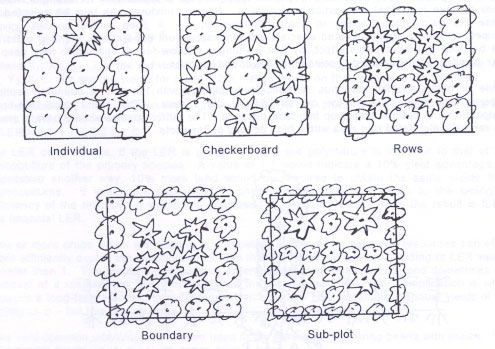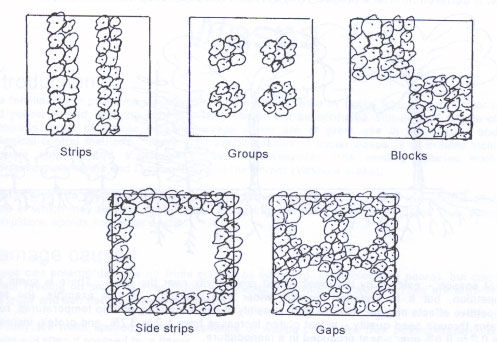Introduction
Most conventional farmers, foresters and landowners are used to growing monocultures of a single crop at a time, measuring the yields from them and managing them accordingly. When confronted with intercropping systems, under planted orchards or forest gardens, the diversity is often beyond their experience and understanding. This article aims to explain a way of measuring and optimizing yields from agronomic systems using several crops growing together.
The Land Equivalent Ratio (LER)
The usual measure used for comparisons involving diverse crops growing together on the same land is the LER. This measure is independent of any monetary units. The equation for calculating LER is:
![]()
Where X1, X2, X3 ... is the individual yield of crop 1,2,3 ... when grown in the polyculture, and Y1, Y2, Y3 ... etc are the yields for crops 1,2,3.. when grown on their own as a monoculture.
So, for example, with two grain crops grown together, if Y1=1 t/ha, Y2= 2 t/ha, X1= 0.7 t/ha and X2= 1.8 t/ha, then:
LER = 0.7/1 + 1.8/2 = 1.6
For LER comparisons, if the LER is greater than 1, the polyculture is superior to that of the monoculture of the primary species. A value of 1.1 would indicate a 10% yield advantage, or expressed another way, 10% more land would be required to obtain the same yields from monocultures. If yields are expressed in physical units, the LER refers to the biological efficiency of the mixture. If yields are expressed in monetary values, then the result is fLER: the financial LER.
Two or more crops which are sharing or competing for the same essential resources can often more efficiently exploit the available resources than can a single species, leading to LER values greater than 1. The crops may also have different resource requirements, and sometimes the removal of a resource by one crop improves the yield of another. one complication is when growing a long-term woody crop with shorter term crops - how to calculate annual yields of the woody crop - but this can be done.
One very common intercropping system used in the Americas is growing beans with maize. The LER values for this system usually range from 1.3 to 1.8.
Another case study of intercropping radishes in a pear orchard found an LER value of 1.65 to 2.01 relating to economic and biomass yield respectively. The fruit yields were unaffected, while the radish plants allocated more biomass to leaves, diminishing the swollen root harvest.
Some other two-crop LER's that have been measured are:
| Crop 1Barley | Yield | Crop 2Field bean | Yield | LER1.85 |
| Beans | 1.00 | Cabbage | 1.23 | 2.23 |
| Bush bean | 1.00 | Carrot | 0.50 | 1.50 |
| Soya beans | 0.66 | Tomato | 1.00 | 1.66 |
| Oats | Short pea | 1.21 | ||
| Oats | Barley | 1.00 to 1.11 | ||
| Potato | 0.90 | Wheat | 0.44 | 1.34 |
LER is maximized when the different crops grown have different resource profiles - i.e. over time they have differing, preferably complementary, needs for light, water, nutrients etc. For two species grown together, the LER will depend partly depend on the planting density and relative proportions of plants (and thus plant-plant interface distances). There will be a point of optimum planting density/arrangement when the LER is maximized.
Plants which occupy different ecological niches when grown together may have the potential to lead to large LER values. Temporal separation is also a valuable tool - for example, growing winter wheat intercropped with a deciduous tree allows the wheat full light access over the winter until the tree comes into leaf.
Individual species have tendencies for certain types of root architecture - for example, wheat tends to have roots that are vertically elongated. Species mixtures can thus be selected to utilize the belowground space in non-competitive ways. A deep rooted species, given competition from a shallow rooted species, will emphasize root separation. Planting patterns can be used to intensify this effect, by first planting a shallow-rooted species to help keep a later introduced, deep-rooted species in the lower soil horizons.
Guide or buffer species can thus be specifically planted with the aim of changing rooting patterns, and thus increase the overall LER of the system (Figure 1). This can reduce tree-crop competition and optimal crop-crop interface distance. The buffer species should have a small but vertically elongated root area with a high density of fine roots.
 |
Figure 1. Lower shows potential productive area wasted through unconstrained tree growth. Upper shows how buffer-guide species can increase the spatial effectiveness of a tree-crop association, guiding the canopy and roots, decreasing the optimal interface distance and increasing the LER. |
Spatial planting patterns
Where crops have the potential to grow well together with a high LER, systems should be based as much as possible on spatial patterns/arrangements having a large amount of crop-crop interface.
When two crops are roughly the same size, fine planting patterns are often used. Maximum crop-crop interface is obtained with a checkerboard pattern, or when rows are used alternate rows give maximum interface. (see fig 2 - fine pattern arrangements)
 |
Figure 2. Fine pattern arrangements |
When crops are different sizes (e.g. a tree plus smaller crop), coarse planting patterns tend to be used - strips, groups, blocks etc. These have a lower per area amount of crop-crop interface but are chosen to maximize other benefits of the diverse system. The areas between the larger species can contain an area of a single crop, an intercrop, a group of shrubs etc. (see fig 3 - coarse pattern arrangements)
 |
Figure 3. Coarse pattern arrangements |
Planting patterns are also strongly affected by the site and socio-economic needs. A user may require live fencing and a boundary pattern while also desiring the ecological dynamics of a gap pattern. A variation or progression might be devised that accommodates both needs.
Diversity of species is important in small-scale agroforests and forest gardens, and is an important factor in making these polycultural systems have some of the highest LER values (3-or more). In terms of number of species, the maximum gains are achieved by having at least 10 species, but gains continue (to a lesser extent) as the number of species increases. Tropical and temperate home gardens / forest gardens contain 50 to 350+ species (the latter found in home gardens in Mexico).
Example: Paulownia - wheat system
To show the complexity of plant interactions, this system, widely used in China, is described. The winter wheat is planted in the early spring between widely spaced alleys of Paulownia trees. Tree-crop competition is minimal in spring but does occur during the latter stages of the wheat season - evident by the lower wheat productivity near the trees. There is some light competition, but it is lessened through wider tree spacing. In this example, the slight competitive effects may be valuable and, possibly due to a lowering of crop temperatures, result in gains through seed quality - wheat gluten increases from 1.0 to 3.7%, and protein increases from 0.2 to 0.6% over wheat produced in a monoculture.
The root architecture of paulownia is interesting. The roots are predominantly in the lower soil layer (80% are 40-100 cm below the surface), 10% are in the upper 10 cm, and 98% are within 5 m of the tree. Wheat has a deep, narrow root structure, so with the overlap in roots there is the possibility of beneficial mechanisms such as hydraulic lift (when the tree roots raise water from deep levels and make it available to other plants).
Above ground beneficial effects are also reported. Trees reduce the wind speed by 45-50%, which in turn increases seed germination from 0.5% to 1.2%, reduces soil evaporation by 15-30%, and increases soil water content by 5-15% over monocultural wheat. In addition, nutrient capture and storage is improved, with fresh paulownia leaves containing 2.8-3% nitrogen and providing the soil with potash and organic matter.
Wheat and fallow or wheat as part of a cropping sequence in this system is sustainable over the long term, and wheat yields are similar to, sometimes slightly more than, monocultural controls, despite some of the land being occupied by trees. The LER for paulownia and wheat is between 1.2 and 1.5 - moderate increases over monocultures (the wheat component being around 1.0 and the tree component 0.2 to 0.5 depending on tree density).
The main economic advantages of the system occur through the tree products harvested and increased market value from improved grain quality.
References
Altieri, M: Agroecology. IT Publications, 1995.
Gordon, A & Newman, S: Temperate Agroforestry Systems. CAB International, 1997.
Innis, D: Intercropping and the Scientific Basis of Traditional Agriculture. IT Publications, 1997. Wojtkowski, P: Agroecological Perspectives in Agronomy, Forestry and Agroforestry. Science Publishers, 2002.
Reprinted by permission from Agroforestry News, Agroforestry Research Trust, Totnes, Devon, U.K.
By Martin Crawford, Agroforestry Research Trust



